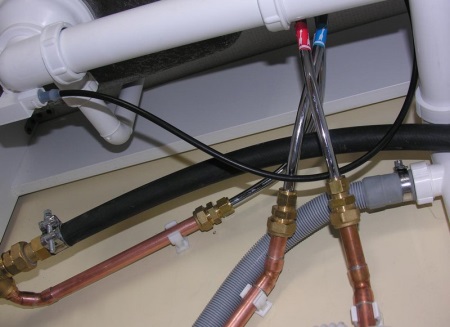Tight fitting for the faucet

A distinctive feature of this kind of supply line is the rigid attachment of the faucet and pipes. Some masters consider it more aesthetic than a flexible supply line, although this is rather a matter of personal preferences and tastes.
Pros
The positive sides of the rigid type of supply lines can include:
- It looks quite stylish compared to the flexible one;
- Long service life, which is about 20 years;
- High quality materials that are not susceptible to corrosion;
- Installation is comfortable enough (although it has its own nuances, so it is not strictly a plus);
- The product is reliable;
- Due to the smooth surface, keeping the grommet clean does not become a problem. Dirt does not accumulate on the tube;
- The device is not afraid of thermal and chemical effects, can withstand higher temperatures and fluctuations than flexible analogues.
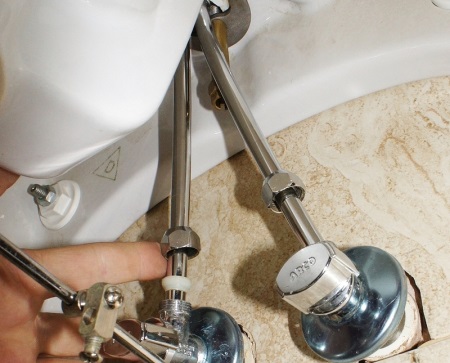
Cons
No matter how you look at it, but you can't do without the minuses here.
We noted that installation is a controversial issue, so it should also be attributed to the minuses. It is quite problematic to perform it, because you are limited in the movement of the supply line. Actually, this forms another disadvantage - stationarity. The product does not bend, does not succumb even to slight deformation, which would allow for a more proper, aesthetic installation.
Otherwise, even experienced professionals do not find serious shortcomings that could characterize the rigid eyeliner.
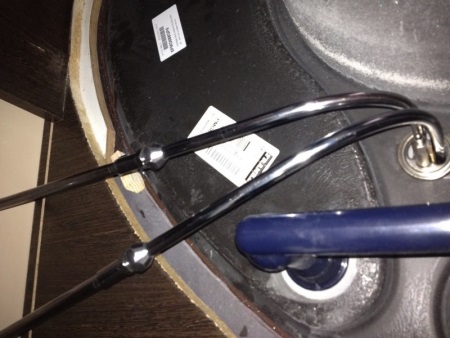
Types
Classify the varieties of rigid eyeliner can be based on the materials of which it is made in our time. It represents tubes made of metal. This metal, in turn, can be:
- Brass;
- Steel;
- Copper.
Which option is more reliable is up to you to decide. It largely depends on the manufacturer and its degree of responsibility for their own products. The most important thing is that the metal had anti-corrosive properties, and not a cheap knockoff. Unfortunately, some companies use conventional black metal, which over time rusts. And to hide this fact, they cover it with special paints and compounds. As a result, the tubes look like steel, copper or brass.
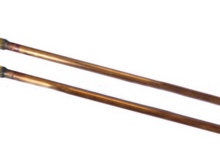

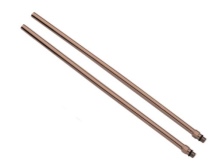
Tips for choosing
When choosing a hard supply line for your faucet, try to follow a few simple rules. They are advisory in nature, but allow you to make a really good purchase.
- Material. Carefully study what material the supply line is made of. In fact, steel, brass and copper have their own advantages and some nuances, so the most important thing is to avoid fakes. If you are told that it is brass, you must be sure of the validity of these words.
- Size. The rigid supply line is a little problematic in that it is demanding to choose the right size. You need to take into account the diameter of the water pipe and the inlet to the faucet. Some homes are equipped with non-standard communications, so before you go to the store, be sure to take measurements.
- Length. A separate topic of conversation. The point is that you need to choose the right length. If the tube turns out to be short, you will have to buy a new one or weld the missing element, which is a last resort solution. If the tube is long, you will not be able to fully install it, because the material does not bend. This is the main problem of selecting a rigid supply line.
- Manufacturer. Now the market has formed its own elite of manufacturers of plumbing and sanitary equipment. Also, there is probably a store in your city that has the most authority. It is desirable to buy products from them. Both the manufacturer and implementer are not interested in losing credibility and customers. That is why they are trying to offer high quality products. It is exactly what you need.
- External aspects. As a rule, the supply line is trying to hide from the eyes, by doing the paneling, installing bathroom furniture and so on. But in some situations, the eyeliner remains in sight, which means you have to pay attention to its design.
- Price. Let us say only one thing - a good eyeliner of the rigid type cannot cost a penny.
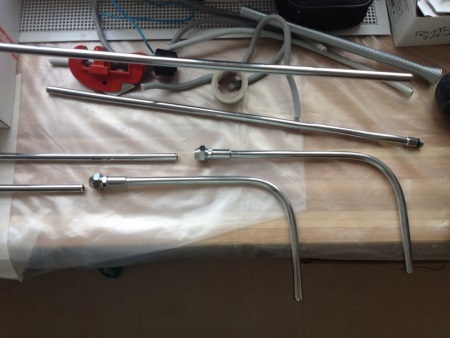
Installation .
Following the sequence of installation work, you will have no problem connecting a rigid supply line to your faucet.
- Determine a place to place the faucet.
- Prepare the wall for the subsequent installation of the pipes. Mark out special strips for placing the pipes. Make a grommet. Some pipes may run along the wall, others may be recessed. Do not forget, the system will have elbows, so pre-mark them on the wall.
- Assemble the pipes. Predominantly, even experienced home craftsmen assign this task to professionals. Anyway, do not forget to screw on the eccentric at this stage. Winding is not yet required.
- Fix the old faucet to make sure that the system is correctly positioned. Don't worry, all models of faucets have identical spacing between the seating points.
- If you have realized that everything is done correctly and evenly, start caulking. To do this, you will need a cement mix. Also provide a layer for the subsequent application of finishing material (since this is a bathroom, most of us use ceramic tiles).
- When the grout mixture dries, you can remove the old faucet and install the new faucet in its place.
- The final step will be the treatment of the surface of the walls and installation of tile. Make sure that all fasteners are tight, so that there are no leaks during operation.

How to put instead of a flexible
You probably can notice that the flexible leads are everywhere, almost everyone in the house, office and so on. It is easy to install and does not cost much.
But how many people know that it should be replaced every 3-5 years?
This is due to the fact that the supply line gets old, the hoses inside it are covered with cracks, seals fail, elasticity is compromised. As a result, leaks are almost inevitable.
In this component, the rigid analogue of the supply line is more reliable, is able to work with higher pressure, and the service life is several times higher.
Experts recommend that when repairing the bathroom to provide an opportunity in the future to connect a rigid linerEven if you now plan to install a flexible. The water supply connectors, located under the sink, should be not more than 0,5 m from the faucet. If this condition is not met, you can use an alternative solution - corrugated pipes. But they must be made of stainless steel.
Unscrew all the old pipes, remove the faucet and turn the corner taps. Screw the tubes into the faucet and make sure everything fits. If not, unbend the product carefully or mark points to cut off excess elements.
After you have adjusted the tubes to the correct dimensions, check the axis ratio and assemble the system. Fix the faucet to the sink first, then tighten the collets. Turn on the water and make sure everything works properly. Also remember to check the system for leaks after a few days. If there is a decorative trim or furniture that covers the system, don't install it yet. Only when you know everything is working properly, close the plumbing.
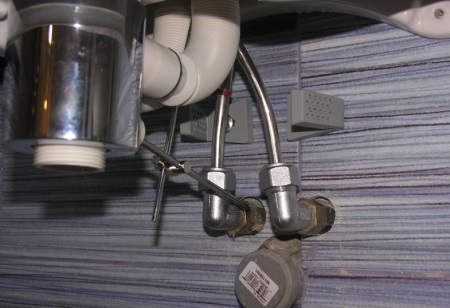
Safety Precautions
Experts recommend using a pipe bender during the installation of a faucet with a rigid supply line. This device allows you to lead the pipes without bending them too much. Overbending can lead to undesirable consequences.
Of course, one of the most important conditions for personal safety is to shut off the water before starting repair work. Observe safety rules, use protective equipment, gloves when working with metal.
